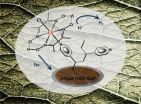(Press-News.org) (SACRAMENTO, Calif.) —Biomarkers for bone formation and resorption predict outcomes for men with castration-resistant prostate cancer, a team of researchers from UC Davis and their collaborators have found. Their study, published online in the Journal of the National Cancer Institute, also found that the markers identified a small group of patients who responded to the investigational drug atrasentan. The markers' predictive ability could help clinicians match treatments with individual patients, track their effectiveness and affect clinical trial design.
Castration-resistant prostate cancer does not respond to hormone treatments and often metastasizes to bone. This led researchers to wonder if increased bone turnover markers might predict the course of the disease.
"We found that patients with high levels of these markers in the blood had a much shorter lifespan compared to patients with low levels," said lead author Primo Lara, associate director for translational research at the UC Davis Comprehensive Cancer Center. "By measuring bone turnover in prostate cancer patients, we can determine how well they do."
Healthy bone maintains a balance between formation and resorption, generating new bone while recycling old. Prostate cancer throws off this balance. Researchers hoped this mechanism would help them track the cancer. To investigate this potential link, the team tested blood serum in 778 patients for both resorption (N-telopeptide, pyridinoline) and formation markers (C-terminal collagen propeptide, bone alkaline phosphatase) and found elevated levels of each of the markers predicted poor prognosis.
Perhaps most interesting, elevated marker levels also predicted whether patients would respond to a specific drug. About 6 percent of patients with the highest marker levels responded to atrasentan, and investigational drug abandoned because it failed in clinical trials. Lara and colleagues believe this may be related to study design.
"Atrasentan kept coming up short in randomized trials because the drug only works for a small group," Lara said. "Because certain drugs only succeed in a fraction of patients, drug makers need to factor in these bone metabolism markers in their trial design. They need to target the patients most likely to benefit."
In addition to determining which patients might respond best to a specific treatment, these markers could be used to track their response during treatment. Marker status could also stratify patients equally within different study arms. Balancing these studies could potentially make them more accurate and identify the niche value of drugs like atrasentan whose effectiveness is not evident in large populations.
"I think the days of doing empirical studies on all comers should end," Lara said. "You need to have an appropriate database of patients and perform a rigorous analysis to find the subset who will benefit from an investigational drug."
INFORMATION:
The study's title is Serum Biomarkers of Bone Metabolism in Castration-Resistant prostate Cancer Patients With Skeletal Metastases: Results From SWOG 0421.
Other researchers included: Philip C. Mack of the UC Davis Comprehensive Cancer Center, Erik Gertz and Marta D. Van Loan of the USDA Western Human Nutrition Center at UC Davis; Benjamin Ely and Catherine Tangen of the Southwest Oncology Group Statistical Center in Seattle; David I. Quinn and Amir Goldkorn of the University of Southern California Norris Cancer Center; Przemyslaw W. Twardowski of the City of Hope; Maha Hussain of the University of Michigan; Nicholas J. Vogelzang of US Oncology; and Ian M. Thompson of the Cancer Treatment and Research Center, University of Texas, San Antonio.
This research was funded by grants from the National Institutes of Health: 5R01-CA120469, CA32102, CA38926 and NCT00134056.
UC Davis Comprehensive Cancer Center is the only National Cancer Institute-designated center serving the Central Valley and inland Northern California, a region of more than 6 million people. Its specialists provide compassionate, comprehensive care for more than 10,000 adults and children every year, and access to more than 150 clinical trials at any given time. Its innovative research program engages more than 280 scientists at UC Davis, Lawrence Livermore National Laboratory and Jackson Laboratory (JAX West), whose scientific partnerships advance discovery of new tools to diagnose and treat cancer. Through the Cancer Care Network, UC Davis collaborates with a number of hospitals and clinical centers throughout the Central Valley and Northern California regions to offer the latest cancer care. Its community-based outreach and education programs address disparities in cancer outcomes across diverse populations. For more information, visit cancer.ucdavis.edu.
Bone turnover markers predict prostate cancer outcomes
Findings could influence treatment and clinical trial design
2014-03-07
ELSE PRESS RELEASES FROM THIS DATE:
Promising news for solar fuels from Berkeley Lab researchers at JCAP
2014-03-07
There's promising news from the front on efforts to produce fuels through artificial photosynthesis. A new study by Berkeley Lab researchers at the Joint Center for Artificial Photosynthesis (JCAP) shows that nearly 90-percent of the electrons generated by a hybrid material designed to store solar energy in hydrogen are being stored in the target hydrogen molecules.
Gary Moore, a chemist and principal investigator with Berkeley Lab's Physical Biosciences Division, led an efficiency analysis study of a unique photocathode material he and his research group have developed ...
Anti-psychotic medications offer new hope in the battle against glioblastoma
2014-03-07
Researchers at the University of California, San Diego School of Medicine have discovered that FDA-approved anti-psychotic drugs possess tumor-killing activity against the most aggressive form of primary brain cancer, glioblastoma. The finding was published in this week's online edition of Oncotarget.
The team of scientists, led by principal investigator, Clark C. Chen, MD, PhD, vice-chairman, UC San Diego, School of Medicine, division of neurosurgery, used a technology platform called shRNA to test how each gene in the human genome contributed to glioblastoma growth. ...
Agricultural fires across the Indochina landscape
2014-03-07
Agricultural fires are still burning in Indochina ten days after the last NASA web posting about the fires. This natural-color image, taken on March 07, 2014, by the Moderate Resolution Imaging Spectroradiometer, MODIS, aboard the Aqua satellite, shows a more comprehensive area of burning agricultural fires that stretch from Burma through to Laos and south throughout Thailand. Actively burning areas, detected by MODIS's thermal bands, are outlined in red.Fire is used in cropland areas for pest and weed control and to prepare fields for planting. Crop residue burning helps ...
NYU researchers find majority of Latinas are unaware of their risk of diabetes
2014-03-07
Approximately 5.5 million Latinas suffer from elevated fasting plasma glucose (FPG) and nearly 4 million of those women were never told by a healthcare provider they were at risk for diabetes, pre-diabetes, or were borderline for diabetes.
The study, "Latinas with Elevated Fasting Plasma Glucose: An Analysis Using NHANES 2009-2010 Data," led by Dr. Shiela M. Strauss, Associate Professor, New York University College of Nursing (NYUCN), points to the urgent need for alternate sites of opportunity for diabetes screenings. There is also a need for effective and culturally ...
Smartphones become 'eye-phones' with low-cost devices developed by Stanford
2014-03-07
STANFORD, Calif. — Researchers at the Stanford University School of Medicine have developed two inexpensive adapters that enable a smartphone to capture high-quality images of the front and back of the eye. The adapters make it easy for anyone with minimal training to take a picture of the eye and share it securely with other health practitioners or store it in the patient's electronic record.
"Think Instagram for the eye," said one of the developers, assistant professor of ophthalmology Robert Chang, MD.
The researchers see this technology as an opportunity to increase ...
For older drivers, study finds, 1 drink may be 1 too many
2014-03-07
GAINESVILLE, Fla. — You may have only had one glass of wine with dinner, but if you're 55 or older, that single serving may hit you hard enough to make you a dangerous driver.
So, baby boomers, what you suspected is true: you can't party like you used to.
Sara Jo Nixon, Ph.D., a professor in the departments of psychiatry and psychology at the University of Florida and doctoral candidate Alfredo Sklar tested how drinking legally non-intoxicating levels of alcohol affect the driving skills of two age groups: 36 people ages 25 to 35 and 36 people ages 55 to 70. They found ...
Software analyzes apps for malicious behavior
2014-03-07
This news release is available in German.
Last year at the end of July the Russian software company "Doctor Web" detected several malicious apps in the app store "Google Play". Downloaded on a smartphone, the malware installed — without the permission of the user — additional programs which sent expensive text messages to premium services. Although Doctor Web, according to its own statement, informed Google immediately, the malicious apps were still available for download for several days. Doctor Web estimates that in this way up to 25,000 smartphones were used ...
Cells appearing normal may actually be harbingers of lung cancer
2014-03-07
HOUSTON -- Seemingly healthy cells may in fact hide clues that lung cancer will later develop, according to a study led by researchers at The University of Texas MD Anderson Cancer Center The research is published online in the Journal of the National Cancer Institute.
Examination of gene expression in patients with non-small cell lung cancer (NSCLC) showed the area adjacent to tumors is rich with cancer markers. In addition, researchers discovered the previously unknown role of a cancer-promoting gene in the airways of smokers with lung cancer.
"We believe this study ...
Pre-term birth and asthma
2014-03-07
Researchers at Brigham and Women's Hospital (BWH) in Boston, Massachusetts, in collaboration with investigators at the Maastricht University Medical Centre and Maastricht University School of Public Health in the Netherlands and The University of Edinburgh in the United Kingdom, have published findings strongly suggesting that preterm birth (prior to 37 weeks gestation) increases the risk of asthma and wheezing disorders during childhood and that the risk of developing these conditions increases as the degree of prematurity increases.
The findings are based on a systematic ...
Hospital food safety measures reduce risk of contaminated hospital food
2014-03-07
A new study found more than 80 percent of raw chicken used in hospitals in food for patients and staff was contaminated with a form of antibiotic resistant bacteria called extended-spectrum beta-lactamase (ESBL) producing E. coli. While sufficient preparation eliminated the presence of bacteria, poultry meat delivered to hospital kitchens remains a potential point of entry for these dangerous bacteria into the hospital. The study was published in the April issue of Infection Control and Hospital Epidemiology, the journal of the Society for Healthcare Epidemiology of America.
"While ...
LAST 30 PRESS RELEASES:
Orthopedics can play critical role in identifying intimate partner violence
Worms as particle sweepers
Second spider-parasitic mite described in Brazil
January 2026 issues of APA journals feature new research on autism, pediatric anxiety, psychedelic therapy, suicide prevention and more
Private equity acquired more than 500 autism centers over the past decade, new study shows
New cervical cancer screening guidelines from the US Department of Health and Human Services
Estimated burden of COVID-19 illnesses, medical visits, hospitalizations, and deaths in the US from October 2022 to September 2024
Smartphone use during school hours by US youth
Food insecurity and adverse social conditions tied to increased risk of long COVID in children
Earliest, hottest galaxy cluster gas on record could change our cosmological models
Greenland’s Prudhoe Dome ice cap was completely gone only 7,000 years ago, first GreenDrill study finds
Scientific validity of blue zones longevity research confirmed
Injectable breast ‘implant’ offers alternative to traditional surgeries
Neuroscientists devise formulas to measure multilingualism
New prostate cancer trial seeks to reduce toxicity without sacrificing efficacy
Geometry shapes life
A CRISPR screen reveals many previously unrecognized genes required for brain development and a new neurodevelopmental disorder
Hot flush treatment has anti-breast cancer activity, study finds
Securing AI systems against growing cybersecurity threats
Longest observation of an active solar region
Why nail-biting, procrastination and other self-sabotaging behaviors are rooted in survival instincts
Regional variations in mechanical properties of porcine leptomeninges
Artificial empathy in therapy and healthcare: advancements in interpersonal interaction technologies
Why some brains switch gears more efficiently than others
UVA’s Jundong Li wins ICDM’S 2025 Tao Li Award for data mining, machine learning
UVA’s low-power, high-performance computer power player Mircea Stan earns National Academy of Inventors fellowship
Not playing by the rules: USU researcher explores filamentous algae dynamics in rivers
Do our body clocks influence our risk of dementia?
Anthropologists offer new evidence of bipedalism in long-debated fossil discovery
Safer receipt paper from wood
[Press-News.org] Bone turnover markers predict prostate cancer outcomesFindings could influence treatment and clinical trial design




